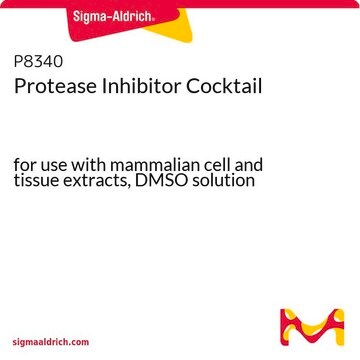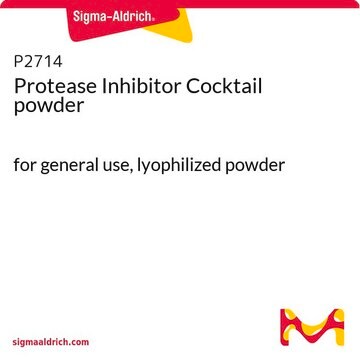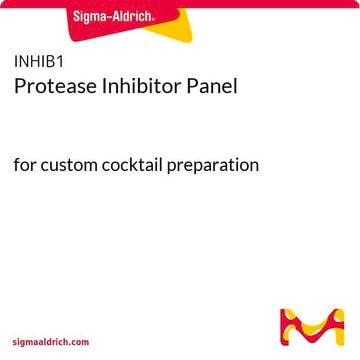Our lab has not conducted testing on the inhibition of P8465 on PreScission Protease. However, considering that the protein structure of PreScission Protease contains a cysteine nucleophile in its active site and the protein folding resembles that of chymotrypsin-like serine protease, it is likely that the inhibition is caused by ABESF and/or E-64, both of which are included in the cocktail of P8465.
Kluczowe dokumenty
P8465
Protease Inhibitor Cocktail
lyophilized powder, for the inhibition of serine, cysteine, aspartic, metalloproteases and aminopeptidases, for use with bacterial cell extracts, lyophilized powder
Synonim(y):
Inhibitor proteazy
Wybierz wielkość
493,00 zł
Dostępny do wysyłki w dniu11 kwietnia 2025Szczegóły
Wybierz wielkość
About This Item
493,00 zł
Dostępny do wysyłki w dniu11 kwietnia 2025Szczegóły
Polecane produkty
Nazwa produktu
Protease Inhibitor Cocktail powder, for use with bacterial cell extracts, lyophilized powder
Poziom jakości
Formularz
lyophilized powder
rozpuszczalność
water: soluble
temp. przechowywania
−20°C
Szukasz podobnych produktów? Odwiedź Przewodnik dotyczący porównywania produktów
Powiązane kategorie
Opis ogólny
The product contains individual components that target serine, cysteine, aspartic, and metalloproteases, as well as aminopeptidases.
Zastosowanie
Działania biochem./fizjol.
Cechy i korzyści
Contains individual components, including AEBSF, EDTA, Bestatin, Pepstatin A, and E-64, each targeting specific types of proteases.
Lyophilized powder is stable for at least 2 years when stored unopened at -20°C.
Supplied with a vial of DMSO for preparation of a cocktail solution.
One mL of the cocktail solution is recommended for the inhibition of protease activity found in 20 mL of cell lysate from 4g of E. coli cells.
Przestroga
Uwaga dotycząca przygotowania
produkt powiązany
Hasło ostrzegawcze
Danger
Zwroty wskazujące rodzaj zagrożenia
Zwroty wskazujące środki ostrożności
Klasyfikacja zagrożeń
Acute Tox. 4 Inhalation - Eye Dam. 1 - Met. Corr. 1 - Skin Corr. 1A - STOT RE 2 Inhalation
Organy docelowe
Respiratory Tract
Kod klasy składowania
8A - Combustible corrosive hazardous materials
Klasa zagrożenia wodnego (WGK)
WGK 3
Środki ochrony indywidualnej
Eyeshields, Faceshields, Gloves, type P3 (EN 143) respirator cartridges
Wybierz jedną z najnowszych wersji:
Certyfikaty analizy (CoA)
Nie widzisz odpowiedniej wersji?
Jeśli potrzebujesz konkretnej wersji, możesz wyszukać konkretny certyfikat według numeru partii lub serii.
Masz już ten produkt?
Dokumenty związane z niedawno zakupionymi produktami zostały zamieszczone w Bibliotece dokumentów.
Klienci oglądali również te produkty
Powiązane treści
Select different protease inhibitor types based on your needs to prevent protein degradation during isolation and characterization and safeguard proteins in sample prep.
Wybierz różne typy inhibitorów proteaz w zależności od potrzeb, aby zapobiec degradacji białek podczas izolacji i charakteryzacji oraz zabezpieczyć białka podczas przygotowywania próbek.
-
Does the protease inhibitor P8465 inhibit PreScission Protease? We utilized P8465 inhibitors in the purification of a GST-tagged protein fraction, and observed low activity of the PreScission protease (GE27-0843-01) on the dialyzed (using 10 kDa MWCO) GST-tagged protein fraction. Can you provide insight into the inhibition of the PreScission protease by this protease inhibitor cocktail?
1 answer-
Helpful?
-
Active Filters
Nasz zespół naukowców ma doświadczenie we wszystkich obszarach badań, w tym w naukach przyrodniczych, materiałoznawstwie, syntezie chemicznej, chromatografii, analityce i wielu innych dziedzinach.
Skontaktuj się z zespołem ds. pomocy technicznej

















